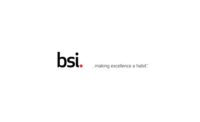Analysis
Organizational Resilience
Harnessing experience, embracing opportunity.


Operational Resilience, Source: BSI






Long-term prosperity in business is rare and decreasing. In the U.S., for example, research has shown that companies currently remain in the S&P 500 index for an average of just 18 years, down from 61 years in 1958. And it’s a similar story elsewhere in today’s dynamic, interconnected world.
Every leadership team will agree that, to ensure lasting success, their organization must become ‘resilient.’ But what does this really mean in practice?
There have been numerous management papers on how and why companies should embrace resilience in order to protect themselves from growing business threats. However, ‘organizational resilience’ is based upon a much broader view of resilience as a value driver for organizations, enabling them to perform robustly over the long term.
Our own recently published Standard BS 65000, defines organizational resilience as “the ability of an organization to anticipate, prepare for, respond and adapt to incremental change and sudden disruptions in order to survive and prosper.” Here, the words “organization” and “prosper” really matter. Organizational resilience reaches beyond survival, towards a more holistic view of business health and success. A resilient organization is Darwinian, in the sense that it adapts to a changing environment in order to remain fit for purpose.
BSI regards organizational resilience as a strategic imperative for all companies, both large and small.
STRATEGIC ENABLER
While there is always an important element of risk management in organizational resilience, it should be equally focused on business improvement.
Organizational resilience is not a defensive strategy, but a positive, forward-looking ‘strategic enabler,’ which allows business leaders to take measured risks with confidence. Robust, resilient organizations are flexible and proactive – seeing, anticipating, creating and taking advantage of new opportunities in order, ultimately, to pass the test of time.
By demonstrating the resilience of their organization – through certification and compliance to recognized standards, for example – leaders are also showing that it is reliable, trustworthy and a company that others would want to do business with. In this way, organizational resilience underpins enviable brand values and priceless reputational benefits.
MASTERING CHANGE
Mastering organizational resilience requires the adoption of excellent habits to deliver business improvement by embedding competence and capability throughout the business and down the supply chain: from products and services to people and processes; and from vision and values to culture and behaviors.
Organizational resilience requires commitment from the whole company. It is founded on the values, behaviors, culture and ethos of an organization. It is the leaders of an organization who drive these ‘soft’ factors. However, to make a difference, it requires top-down direction and bottom-up engagement, through clear communication and a willing embrace from all employees.
LEARNING FROM EXPERIENCE
The writer and philosopher Aldous Huxley observed, “Experience is not what happens to a man; it is what a man does with what happens to him.” Similarly, resilience is not what happens to an organization, it is what the organization does with what happens to it.
The most resilient organizations are eager to learn from their own and others’ experiences to minimize problems and grasp opportunities. Peer-to-peer networking and knowledge sharing are vital, for example, when they seek to invest in new areas, introduce innovative products and processes or penetrate new and unfamiliar markets.
BUILDING A RESILIENT ORGANIZATION
BSI’s model for organizational resilience comprises three fundamental elements:
Product excellence
In this context, ‘product’ refers to whatever product, service or solution an organization brings to market. Organizations must ask themselves which markets they serve. Do its capabilities and products match those markets’ requirements and comply with their regulatory environment and if not, how can it adapt them? Truly resilient businesses innovate, creating new products and markets, and differentiating their offering to stay ahead of their competitors.
Process reliability
Embedding best practice in developing and marketing products and services is a key component of success. Resilient organizations ensure that they ‘do the basics right’ consistently through the strength and reliability of their processes, while still leaving scope for innovation and creativity. Business-critical processes in the management of areas such as quality, environment, health and safety, information security and business continuity must be robust and compliant, both within an organization and also throughout key parts of its supply chain.
People behavior
Resilient organizations seek alignment between customer expectations and employee engagement. Contemporary organizations are inclusive and consultative, not simply dictating rules to be followed, but encouraging employees’ behavior to become an integral part of their job and their organization’s culture. The challenge for the organization is to understand, articulate and demonstrate their values clearly, so that everyone ‘lives’ them, not because they’ve been told to, but because ‘it’s the way we do things around here.’
BSI’s model is deliberately drawn as a positive feedback loop, with process excellence driving up product reliability, indivisibly linked to the people behavior of an organization. Long-term resilience requires looking at your organizational capabilities holistically, enabling you to hold on to new ground, and to strive for continual improvement.
The model further summarizes the defining qualities of resilient organizations – the benefits that show them to be a breed apart:
- Strategic adaptability – giving them the ability to handle changing circumstances successfully, even if this means moving away from their core business.
- Agile leadership – allowing them to take measured risks with confidence and to respond quickly and appropriately to both opportunity and threat.
- Robust governance – demonstrating accountability across organizational structures, based upon a culture of trust, transparency and innovation, ensuring they remain true to their vision and values.
WHERE RESILIENCE IS KEY
While there are many business functions that would benefit from a focus on resilience, BSI identifies three domains today that are critically important in achieving organizational resilience in both large and small companies:
Operational resilience
A resilient organization has a full understanding of how it is run and the environment in which it operates. This includes identifying operational improvements across its products/services and processes in order to meet the needs of its customers over time, through to how an organization values its people and governs itself. It requires demonstrable evidence that the organization is not complacent and is always challenging itself to improve performance and grow sustainably
Supply chain resilience
As supply chain networks increasingly span continents and become more complex, the ability to quantify and mitigate supply chain risks throughout the procurement, manufacturing, transportation and sales lifecycle is paramount. Organizations need to identify the critical risks to minimize disruption and help protect global operational, financial and reputational exposures.
Information resilience
In today’s world, organizations must be trusted to safeguard sensitive information. A resilient organization must manage its information – physical, digital and intellectual property – throughout its lifecycle, from source to destruction. This requires the adoption of information security-minded practices that allow stakeholders to gather, store, access and use information securely and effectively.
STAND OUT AND WIN
To stand out and win, every organization, regardless of its size, sector or location, must develop an approach to resilience that is right for it – underpinned by its values and defining its brand.
The legacy of a true leader will be determined not so much by what is achieved today but by what the organization achieves in the future.
REFERENCE
1 Source: Creative Destruction Whips Through Corporate America, Foster R. Innosight. 2012
BSI America Group Inc.
12950 Worldgate Drive
Suite 800
Herndon, VA 20170
Looking for a reprint of this article?
From high-res PDFs to custom plaques, order your copy today!











